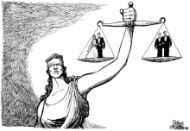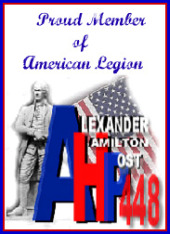 I went to college in the middle of the Vietnam War years. Though I’d had my VW painted purple and maybe even had a peace sticker on the back window, I was hardly a hippie or a protester. Right at the time I started college, my brother had just come back from Vietnam and gotten out of the army, so I was personally aware of the war and its consequences, but I’d really never thought about whether I was for or against it.
I went to college in the middle of the Vietnam War years. Though I’d had my VW painted purple and maybe even had a peace sticker on the back window, I was hardly a hippie or a protester. Right at the time I started college, my brother had just come back from Vietnam and gotten out of the army, so I was personally aware of the war and its consequences, but I’d really never thought about whether I was for or against it.
I went to college in Hays (Fort Hays State) and sometimes drove the 44 miles home on the weekends. Forty-four miles seemed much further in those days, and some of the trips back to school on a Sunday night felt long, especially in the winter. The VWs of the 60s had terrible heaters, and sometimes the car never got warmed up the entire ride, and if there was snow or sleet, it would freeze on the windshield because the defroster had so little effect. I know there were times that it was so difficult to see through the windshield and through the blowing snow that it was only because the car knew its own way that we got back to Hays.
However, being light-weight and having the engine in the back, the car got really good traction. Because of that, if the streets around Hays hadn’t been plowed clean, my roommates would always get me to drive. My last year at Fort Hays, we had gone back for inter-session ( a short 2-week mini-semester) early in January, but there had been such a big blizzard that they called off classes for a few days. Of course, we had to get out of the apartment anyway. We found out that the movie theater downtown was open, so we got into the VW and headed out. With the weight of four guys in the car, we moved pretty well through the snow-filled streets, but sometimes we’d run into a drift in the road and the car would just get stuck; then, the other three would jump out of the car and push it through, jump back in and off we’d go. When we finally made it downtown, there weren’t many other cars out and the crowd inside the movie theater was a meager bunch of the most hardy of souls, or maybe the craziest. I guess we felt something like pioneers for being able to get ourselves through all that snow to watch a movie.
The student population at Fort Hays was very homogeneous in those days. The farm population of western Kansas was already dwindling, but not nearly as much as it has in more recent years. Most little towns still had their own high schools as consolidation had just barely started. Like me, the majority of the students came from small Kansas towns and from a more or less isolated existence. There were some out-of-state students and a few foreign students, but most of us came from the same rural background. The first black guy I met was at Fort Hays, but he too was from a small western Kansas town. (Nicodemus, Kansas was started by the exodusters, freed slaves from the South, who settled in western Kansas after the Civil War.) The people I went to school with were basically nice people, really good people, but I think most of us had grown up relatively naive to what was going on very far beyond our part of the state.
Even so, there were a few anti-war rallies on campus, but they were tame in comparison to most, and certainly there were no campus buildings damaged or destroyed by war protestors like happened at KU and some other campuses around the country.
 There was a “head shop” that sold mostly black lights and black light posters, but drug use wasn’t that big. Like most college towns, there were a few bars and clubs that attracted students, but aside from weekends, I didn’t know that many people who drank that much. However, one of my roommate’s dorm friends was a pothead of sorts. Through him, I had my first and only experience in Hays of getting high. He had this stash–and, yes, it was truly stashed. One night four of us went out to the college farm to this pasture testing area. There were some test plots, which had fences around them in order to let the native plants grow and prevent the cows–or maybe buffalo (they had some buffalo out there too)–from eating them. We drove all over the place until we located the right plot, and the guy who had the pot stashed went and dug out this big bag of pot–I mean it was about the size of a bread sack. (I wonder how much that amount might be worth today.) He got back in the car, and we drove to another place there on the college farm, which looked out over the city. (At about 15,000 it was a city to all of us from towns of 300 or so.) He rolled some, and we proceeded to smoke it, looked at the glowing city lights, peered through the swirls on glass Pepsi bottles, and laughed a lot. I don’t know whether I got high from smoking the marijuana or just from the excitement of that new experience, but whatever, it all felt a bit dangerous but nonetheless fun.
There was a “head shop” that sold mostly black lights and black light posters, but drug use wasn’t that big. Like most college towns, there were a few bars and clubs that attracted students, but aside from weekends, I didn’t know that many people who drank that much. However, one of my roommate’s dorm friends was a pothead of sorts. Through him, I had my first and only experience in Hays of getting high. He had this stash–and, yes, it was truly stashed. One night four of us went out to the college farm to this pasture testing area. There were some test plots, which had fences around them in order to let the native plants grow and prevent the cows–or maybe buffalo (they had some buffalo out there too)–from eating them. We drove all over the place until we located the right plot, and the guy who had the pot stashed went and dug out this big bag of pot–I mean it was about the size of a bread sack. (I wonder how much that amount might be worth today.) He got back in the car, and we drove to another place there on the college farm, which looked out over the city. (At about 15,000 it was a city to all of us from towns of 300 or so.) He rolled some, and we proceeded to smoke it, looked at the glowing city lights, peered through the swirls on glass Pepsi bottles, and laughed a lot. I don’t know whether I got high from smoking the marijuana or just from the excitement of that new experience, but whatever, it all felt a bit dangerous but nonetheless fun.
My social life was typical of most of the “dormies”. Most of the students at Fort Hays were either dormies, lived in a frat or sorority house, or lived at home and commuted. Of course, like my roommates and I during our final year, some of the dormies eventually moved into apartments.
Looking back, the four of us probably could have been classified as nerds, but I don’t think there was such a stigma of being studious as there is today. The three of them were science majors of one kind or another and I was an English major. They studied more than I did, but we all ended up getting good grades. On the other hand, after living in the dorm for three years, we did like to have parties. About once a month, on a Saturday night, we’d throw a party, inviting everyone we knew. Of course, it was always alcohol-centered. If food was involved, there was never anything much more elaborate than some bags of chips. Sometimes, we’d have a “trashcan party”. We’d get some cans of Hi-C, pour it into a big plastic trash can, then everybody would add whatever booze they’d brought into the can. Sometimes, there would be 60 or 70 people inside our small two-bedroom apartment on Custer Drive, with the majority of them spilling out onto the balcony that ran all along the second floor. Well, maybe we weren’t such nerds (and maybe some people did drink quite a bit) after all.
Somehow I got this girlfriend, the first semester of my senior year. I had had a few dates before then, but for the most part, I was scared of girls. Don’t get me wrong; I liked girls, and always had lots of friends who were girls, starting from grade school. Dating, though, was a different matter. In college, I was pretty out-going and involved with student government and other organizations, and lots of other guys I knew were dating, and even getting married, so I guess I felt it was something I should do. I really never felt pressured to do it, for sure not from my roommates, who had less going on in that part of their social lives than I did.
Anyway, that fall, I started dating this girl, who was a year younger than I was. I guess you could say she was on the aggressive side when it came to making the moves. No doubt, she was more experienced than I was, because I had never had any kind of physical relationship with a girl up till then. She seemed to really be into me, so at the beginning I liked going out with her. She liked to come out to our apartment and get me into my shared bedroom, even with the roommates out in the living room, which sort of embarrassed me. There were two things, though, making me reluctant to go all the way: one, I just wasn’t quite as interested in doing it as she was, and second, my mom had put “the fear” in me when I was back in high school about getting a girl pregnant. So while we can say there was sometimes a lot of frenzied action, “no deal was ever completed”.
We soon “started going steady”, exchanging high school class rings and framed photographs. Then not too far down the road, she got me even to look at some engagement rings in a downtown jewelry store. I didn’t think about it at the time, but in hindsight, I realized that this girl was one of those who went to college to get an M.R.S. degree. One weekend, we drove out to meet her parents in Ulysses, where her dad was a school administrator.
Saturday of that weekend, we went around town looking at different churches because the church she and her parents attended would just not do for the wedding she was thinking about; it wasn’t big enough nor nice enough. Mind you, I had not even asked her to get married, but to her it was a foregone conclusion. Sunday morning, we all went to their church, a Baptist church. (Growing up, I went to the Methodist church in Dorrance with my family, and it was pretty low key: a lot of singing of hymns, which I liked, and listening to the boring sermons, which were mostly about how to be a good person, and probably sometimes about how people needed to give more money. When I was about 13 or 14, there were three of us who took catechism classes at the church parsonage in Wilson, taught by the grizzly old preacher that we had at that time. We had to learn Bible verses and other lessons in order to become full members of the church. I really didn’t like going because this old geezer thought that he really had to put the “fear of God” in us. He treated us like we were stupid and primarily terrified us. In the end, I did become a member of the church, but I never liked going after that.) I knew people who were Baptists when I was growing up, and they were no different than any of the rest of us Methodists, Lutherans, Catholics, or whatever. I guess maybe they weren’t supposed to dance, but I think at that time if you were really a strict Methodist, you weren’t supposed to dance either.
But this Baptist church in Ulysses was really different. The preacher was one of those “fire and brimstone” types, and he said that if you weren’t a Baptist, you were going to Hell, but you couldn’t be just any Baptist; if you weren’t a member of that particular Baptist church there in Ulysses, you were going to Hell.
Needless to say, I was beginning to feel like a runner caught between second base and third base in a squeeze play. That drive back to Hays was one that I couldn’t wait to end, and over the next few weeks, I began to distance myself. I knew I didn’t want to get married to this girl, (and somewhere in the back of my mind, I knew that I didn’t want to marry any girl), not because of what had happened during that weekend, but I knew I wasn’t in love with her.
She still had one more card to play; a couple weeks later, she called up and told me that her period was late. I didn’t do anything but worry for a couple of days, wondering how her being pregnant was biologically possible and what I would do if she were. Then finally convinced by a mutual friend, she told me that she had made it up. The one thing I wanted back was my class ring, so I went over to her dorm with her ring and picture. She still had a couple more scenes left in that little drama of hers; when I took her ring and picture back over to her dorm, she started screaming and threw my ring and framed picture down the stairwell at me, shattering the glass all over the place.
Sometime after I had graduated and was already in the Air Force, I heard that she was able to get that M.R.S. degree. Over the years, I’ve thought back on that fall of my senior year and what a miserable mistake it would have been if that relationship had gone any further.
____________________________________________________________________________________________
You may also want to read VW Bug and a Summer Job, VW Bug and a Summer Job, Chapter 2, and VW Bug and Saturday Night in a Small Town.
Filed under: Cars and More, Maps, Geography, and Places, Politics and Gay Topics, The VW Bug Chronicles | Tagged: Baptist, blizzard, buffalo, college life, dorm life, dorrance, exodusters, Fort Hays State, gay, GLBT, Great Plains, Hays Kansas, head shop, M.R.S. degree, marijuana, Methodist church, Nicodemus Kansas, roommates, Ulysses Kansas, Vietnam War, VW beetle, VW Bug, Wilson Kansas | Leave a comment »
 This Monday has been a long one (and by the time I finish this, it’s sure to be Tuesday), but at this point, I know I’ve made some accomplishments.
This Monday has been a long one (and by the time I finish this, it’s sure to be Tuesday), but at this point, I know I’ve made some accomplishments.



 http://jointheimpact.com
http://jointheimpact.com


 My mother passed away the day before Barack Obama was elected to be the next President and gay marriage lost in California. Three days ago was her birthday.
My mother passed away the day before Barack Obama was elected to be the next President and gay marriage lost in California. Three days ago was her birthday. Sometime during my junior year in college (69-70), many of us guys sat nervously around the radio, waiting to hear what our draft number would be. I’m not sure how the Selective Service had determined the order of eligible young men to be called up for military service prior to that time, but at the end of the 60s, a lottery system was put into place, and the order a date of birth was pulled from the jar determined how high or how low a guy’s chances of being called up would be. Therefore, if you had a low lottery number (under a 100 at least), your chances of being drafted were very high. If your number was larger, say in the 300s, your chances of not being drafted would much better.
Sometime during my junior year in college (69-70), many of us guys sat nervously around the radio, waiting to hear what our draft number would be. I’m not sure how the Selective Service had determined the order of eligible young men to be called up for military service prior to that time, but at the end of the 60s, a lottery system was put into place, and the order a date of birth was pulled from the jar determined how high or how low a guy’s chances of being called up would be. Therefore, if you had a low lottery number (under a 100 at least), your chances of being drafted were very high. If your number was larger, say in the 300s, your chances of not being drafted would much better.







 It was a big old musty building, the standard small town, wooden-type, painted green and white. They didn’t even turn the electricity on for those two months, but there were enough windows in the waiting room and the main office room to get pretty good light. I had to keep them opened up to get some air in, especially since June and July are hot months. About one-half of the depot building was a big freight room, which was dark and pretty dirty. It had a big sliding, barn-type door, which I could open up just to take a look around or release the built-up heat. When they had closed up the depot, they had taken everything; there was no desk, no waiting room benches, no freight carts. There was, however, the built-in telegrapher’s desk in the bay window (I know it’s not called that in depot architecture, but it’s all I can think of now) that stuck out so that you could see the tracks and the trains coming, the railroad phone, and the chair I had brought with me. There was still the telegraph, and the depot agent from Lincoln would use it sometimes–I think just to gossip on with some of the other guys who still knew how to use it–but for regular railroad communication, everyone used the phone.
It was a big old musty building, the standard small town, wooden-type, painted green and white. They didn’t even turn the electricity on for those two months, but there were enough windows in the waiting room and the main office room to get pretty good light. I had to keep them opened up to get some air in, especially since June and July are hot months. About one-half of the depot building was a big freight room, which was dark and pretty dirty. It had a big sliding, barn-type door, which I could open up just to take a look around or release the built-up heat. When they had closed up the depot, they had taken everything; there was no desk, no waiting room benches, no freight carts. There was, however, the built-in telegrapher’s desk in the bay window (I know it’s not called that in depot architecture, but it’s all I can think of now) that stuck out so that you could see the tracks and the trains coming, the railroad phone, and the chair I had brought with me. There was still the telegraph, and the depot agent from Lincoln would use it sometimes–I think just to gossip on with some of the other guys who still knew how to use it–but for regular railroad communication, everyone used the phone.



